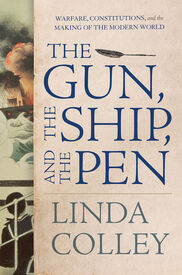The Gun, the Ship, and the Pen

Warfare, Constitutions, and the Making of the Modern World
by Linda Colley
Completed: May 18, 2021- History
- 512 pages
- ISBN: 9780871403162
- Goodreads page
Why ‘reject or ignore something which is correct… simply because it comes from others’? Khayr al-Din Tunisi, The Surest Path, 94, 110, 162-4
This was a great read. If the topic is something of interest, I highly recommend it. However, if you aren’t drawn to such a topic, chances are that you might find the book dry (as is wont to be the case with most history books). The basic theme is noted in the title and subtitle of the book itself - our cursory understanding of written constitutions as being the birth of modern democracy built on principles of freedom and liberalism (typically from looking at the US Constitution with rose-tinted glasses) is inaccurate. War, unsurprisingly (and more accurately the increase in ‘hybrid warfare’ - armies & navies), played a big role in how written constitutions came to be in most places in the world.
Few exercpts:
From the 1750s, and in some particularly war-torn countries such as Sweden even before that, widely distributed iconic texts and single document constitutions aimed at constraining governments, and promising a variety of rights, became more numerous and more prominent.
For Paoli and for Corsica – as would be the case later on for many other peoples in many other places – it was in large part the threat of war, and the outbreak of war, that enabled, enforced and influenced innovative written constitutionalism.
To a degree, then, these men of Philadelphia faced similar challenges to those confronting many European and Asian regimes by the mid eighteenth century. Like the latter, the delegates at Philadelphia and their supporters had to plan how to recover from the strains and damage of massive warfare. Simultaneously, they had to work out how to provide for sufficient levels of citizen solidarity and fiscal-military preparedness in the event of future armed conflicts which they might not choose, but which might happen anyway. ‘Nations in general’, warned John Jay, ‘will make war wherever they have a prospect of getting anything by it.’ What ‘fleets could they ever hope to have’, he worried, acknowledging the rising currency of hybrid warfare on the world’s oceans, if the United States remained fractured and internally at odds. And how could such things possibly be afforded?
‘The objects of the Union, he thought were few’, a blunt Roger Sherman told his fellow delegates in June 1787: 1. Defence against foreign danger. 2. [Defence] against internal disputes & a resort to force. 3. Treaties with foreign nations. 4. Regulating foreign commerce, & drawing revenue from it … These & perhaps a few lesser objects alone rendered a confederation of the States necessary.
This capacity of the British state after 1700 to engage repeatedly in war without experiencing extreme financial meltdown or – outside of Ireland – undergoing severe domestic fractures, was aided by something more than its own formidable capacity to tax, borrow and generate wealth. By 1800, Britain’s paramilitary East India Company had been able to build up an army in the subcontinent of over 200,000 men, most of them South Asian troops, and all of them paid for out of Indian taxes.
British governments thus became able to focus most of their domestic defence spending on maintaining a massive navy, while supplementing their own land forces with a huge foreign army that was increasingly employed in multiple contintents – a foreign army, moreoever, that was not paid for by Britons at home but rather by their captive Indian subjects.
White settlers throughout the Pacific zone (and beyond) made use of another weapon. They deployed written constitutions as a means to advance, legitimise and entrench their actions. This point needs underlining because while historians in recent years have reconstructed some of the ways in which empires employed a broad repertoire of laws to order their captured territories and subjugate the native populations, the degree to which the new political technology could itself function in this fashion has been neglected or glossed over. In part, I suspect, this is because of a lingering notion that written constitutionalism has been invariably benevolent and normally acted as a liberating force. Yet, in regard to Indigenous peoples, as less lethally with women, constitutions frequently worked – and were designed to work – as a means to exclude and marginalise.
The American constitution was substantially redesigned by the victors in the Civil War, both so as to allow Washington to intervene in the states more aggressively and to alter the compass of citizenship and the nature of political rights. These actions were combined, moreover, with the imposition on a defeated South of new, more capacious state constitutions. Thus, in 1869, Virginia, still under stern occupation by federal troops, had to commit to enfranchising all of its male citizens over the age of twenty-one, and to providing public education for all, Black and white, ‘to prevent children growing up in ignorance.’
All book cover images are from Goodreads unless specified otherwise.